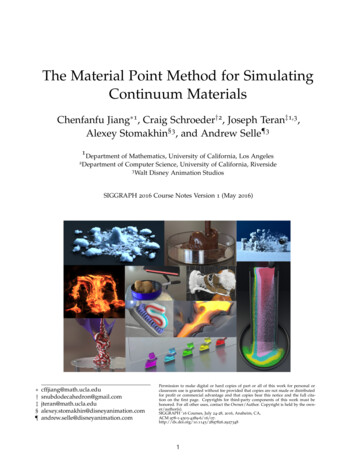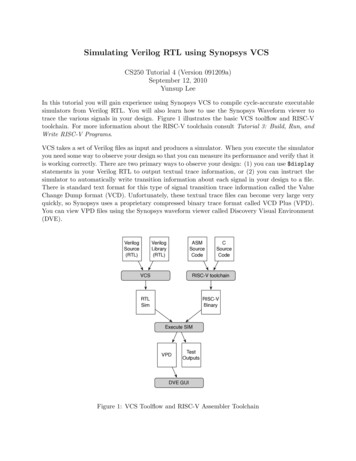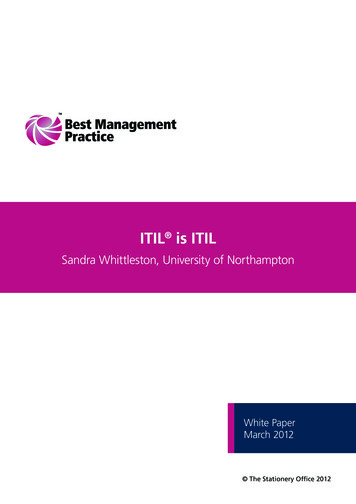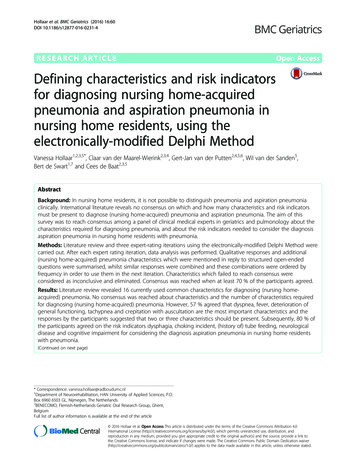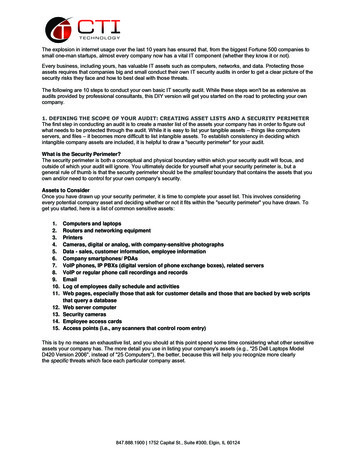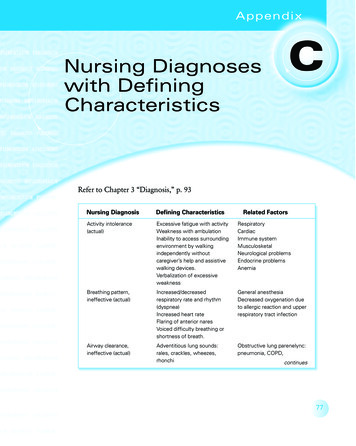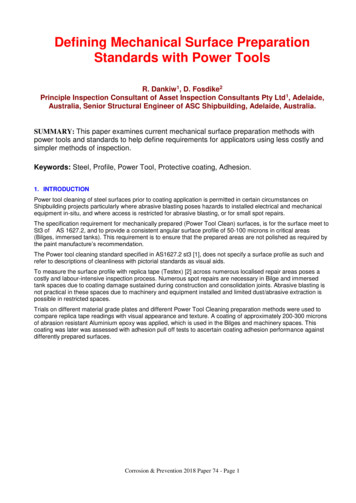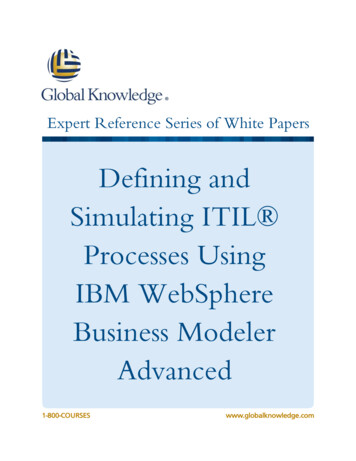
Transcription
Expert Reference Series of White PapersDefining andSimulating ITIL Processes UsingIBM WebSphereBusiness m
Defining and Simulating ITIL Processes Using IBM WebSphereBusiness Modeler AdvancedMichael S. Scarborough, ITIL v2 Service Manager, ITIL Expert, PMP, CISSPIntroductionThis white paper demonstrates the use of IBM WebSphere Business Modeler Advanced (WBM) to define,simulate, reengineer, and improve Information Technology Infrastructure Library (ITIL) processes, as well as someadditional uses of WBM. Unless otherwise noted, this white paper refers to IBM WebSphere Business ModelerAdvanced v. 7.0.What is IBM WebSphere Business Modeler Advanced?IBM’s WBM is a process modeling tool that provides capabilities not found in many process modeling toolsavailable in today’s market. WBM lets users create, define, model, simulate, and analyze various processes inorder to better understand how those processes work in a live business environment.Most organizations have a need to define and understand how various processes used throughout their businesswork, and often need to make changes to those processes in order to increase business value. Unfortunately,there are very few methods available to make changes to a business process without risk of negative impact tothe business. WBM not only provides a way to visually define process flows, but also a way to reengineer andsimulate process flows. Simulation of process flows provides empirical evidence that lets decision makers modifyand improve processes while minimizing the risk of those changes. In other words, WBM provides a way todemonstrate how a change will affect a process in a safe manner before that change is implemented in the livebusiness environment.Some of the key features of WBM include: Process modeling, simulation, and analysis. Not only does WBM provide the ability to visually defineprocess flows, it lets organizations experiment with changes to those process flows and understand theeffects of those changes through simulation. Process improvement based on Key Performance Indicators (KPIs). Many organizations are faced with aregular need to change, adapt, and adjust various processes that support their business. Ideally, this typeof change isn’t done haphazardly. WBM provides the ability to understand performance of a processbased on KPIs, resulting in an ability to make decisions using key metrics that are important to theorganization. Alignment with the business. WBM supports collaboration with the business through both visual andBusiness Process Modeling Notation (BPMN) views of processes. WBM creates a shared understanding ofcritical process activities that transcends one part of an organization. Understanding of existing process flows. WBM works with common process modeling tools and canimport existing process flows in numerous formats. Quick-start process design. WBM provides various templates that represent process flows and otherassets that can be used quickly to save time and money during process design activities. Additionally,Copyright 2016 Global Knowledge Training LLC. All rights reserved.2
WBM makes it easy to copy an existing process and change it in response to business needs. WBM is a broadlyfunctional, process design, modeling, simulation, and improvement tool. This white paper discusses many keyfeatures of WBM using a sample request fulfillment process. Request fulfillment is an operational process definedby ITIL that is common to service management programs throughout organizations.While this paper primarily discusses how WBM can be used as part of an adoption of service management bestpractices, WBM is a tool that supports many uses in an organization and is often seen as part of animplementation of Service-Oriented Architecture (SOA).What Is ITIL?ITIL is a set of best practices that define various common activities that organizations perform. ITIL is the de factoapproach that organizations delivering services follow. For example, ITIL defines processes such as changemanagement, incident management, problem management, and request fulfillment, among many otherprocesses, that are common processes that many organizations perform to underpin their business activities.Many adoptions of ITIL suffer from a lack of an ability to model, simulate, analyze, and ultimately improve thesevarious service management processes, resulting in reduced efficiency and effectiveness of an investment inservice management.ITIL encourages organizations to be formal about how their services, processes, roles, and resources are definedand managed. Many organizations suffer from a lack of formality in key areas. This information often leads toinconsistency, and inconsistency in operational behavior tends to lead to increased costs of IT support and lowerquality.In this white paper we use a common service management process, incident management, to demonstrate thecapabilities of WBM, as well as how organizations can exploit WBM to gain business value. Incident managementrefers to a process design to handle common everyday interruptions and degradations of service that mostorganizations spend significant amounts of their budget handling. Incidents are interruptions or degradations toservices. Imagine an organization has promised that a service will behave a certain way under certain conditions.When it doesn’t behave in line with that promise, ITIL refers to that as an incident. Common examples ofincidents include a network latency issue that impacts the business, an interruption to an online system thatprevents the business from performing work, or a failed change to an IT system that has caused significantbusiness impact.Basic Features of IBM WebSphere Business Modeler Defines business items. Business items are objects that are used, transformed, or created by processactivities. A key feature of WBM includes the ability to define various basic and complex attributes forbusiness items. Basic attribute types are things like text and integer, among others, whereas complexattribute types might combine multiple additional business items. Additionally, WBM provides the abilityto select custom icons for business items, which is a key feature that can be used to visually show how aprocess affects a business item as activities are completed.Defines processes. Like many process modeling tools, WBM provides the ability to define a processworkspace that allows for visual definition of process artifacts.Defines resources. Resources are items that are used by processes as activities are completed. Resourcesin WBM come in two forms: bulk, which is used to refer to equipment and tools, and individual, which isused to refer to people-type resources.Defines roles. Personnel resources can be assigned roles, which are boundaries that specify activities thatare done as part of a process.Copyright 2016 Global Knowledge Training LLC. All rights reserved.3
Creates different process components. WBM provides the ability, again like many other processmodeling tools, to define aspects of a process, including: tasks, human tasks, business rules tasks, while,do-while; and for loops: decisions and gateways and process vents.Defines and uses receive tasks as part of a process map. One of the most important basic features ofWBM is the ability to create “receive tasks” as part of a series of process steps. Basically, a receive task isan asynchronous task that waits on something that arrives at an indefinite time. This very importantbasic feature is not commonly available in process modeling tools.Defines business services and business service Objects. Business service definition is an important aspectof a service management program, and WBM provides the ability to clearly define the business servicesof an organization. Business service objects are specific object types that are used, transformed, andcreated by business services.Serves as a repository of process-related collateral. One often unspoken feature of WBM is its ability tobe a de facto repository for process-related definitions, specific task information, role and resourcedefinitions, and definitions of services. WBM can be a way that organizations store how they intend fortheir process activities to work in a live environment.Why Is WebSphere Business Modeler Ideal for Definingand Modeling ITIL Processes? Ability to create detailed process flows. Like many process modeling tools, WBM provides the ability,using many of the basic features described above, to create useful representations of ITIL processes.Ability to identify associated costs, roles, and other factors related to process activities. Where WBMreally shines is not only in the ability to define specific process tasks and behavior, but to clearlyassociate the roles involved in various tasks; how business items are created, transformed, andconsumed by processes activities; what roles are involved in processes activities; as well as whatthose process activities cost and the associated revenue generated.Ability to show transformation of inputs and outputs throughout a process. Many organizationsregularly build detailed process maps that they then store online or print and display on an officewall. What many of these process flows lack is the ability to show throughout the completion ofprocess activities, how inputs are transformed into outputs. This is a simple feature of WBM, but it isvery important, as it gives a graphical indication of how inputs are being used and how outputs arebeing created during the course of a process.Ability to simulate processes. A key feature of WBM is the ability to take a defined process and runcountless simulations of that process to gain an understanding of how the process will perform in arealistic business setting. The simulation feature of WBM provides key empirical evidence that can beused to validate and test process reengineering assumptions and to provide empirical evidence thateither supports or rejects a predicted outcome.Supports process reengineering activities. One of the perennial problems with process reengineeringactivities is that it is often impossible without making a change in the business environment tounderstand the effect of a process improvement. This is very risky, as a process change that looksgood on paper might disrupt business activities and negatively impact revenue. Through itssimulation function, WBM provides the ability to change, test, and simulate multiple versions ofprocesses until an ideal flow is identified. WBM also provides empirical evidence that can be used tojustify and predict the effects of process reengineering activities.Provides auditable process information. Many organizations interested in ITIL are often subject tovarious audits. Organizations often have difficulty documenting all of their ITIL process informationand activity in a single place. WBM provides the ability to comprehensively document all aspects ofITIL processes, which can be used in support of audit of intent activities.Copyright 2016 Global Knowledge Training LLC. All rights reserved.4
Provides empirical evidence for process-related decision-making. ITIL encourages organizations totake a formal and empirical approach to decision-making around an organization’s servicemanagement processes. WBM provides both the formalization of process artifacts that manyorganizations require, as well as the ability to use that evidence to make decisions about variousaspects of processes. For example, an organization could create various “process scenarios” based onever-changing resource cost to get an understanding of how processes perform relative to differentcost constraints, and make decisions about process activities accordingly.Supports audit activities. WBM provides a repository of process-related information, which oftensatisfies a need that many organizations encounter when adopting service management bestpractices. That is, WBM provides a repository that documents how an organization intends for itsprocesses to work. This repository function can be instrumental during a service management audit,especially for organizations that are pursuing ISO/IEC 20000 registration.Defining a Process Using WebSphere Business ModelerFigure 1. Defining a Simple ProcessDefining a new process is simple in WBM. The new process wizard is invoked to provide the ability to name anddescribe the process. In this case, I’ve chosen to model an ITIL incident management process and given it a fittingdescription.Very little information other than a name is required to define a new process in WBM. However, themore information at hand during process definition, the better understanding of that process the organizationwill have. WBM is best used when working with a full and complete set of information about various aspects ofan organization’s processes, including the inputs used and outputs created, resources and roles involved, as wellas what the various steps of a process cost the organization, and what revenue, if any, they produce. This level ofinformation about processes will ultimately support the ability to simulate process activities and make decisionsbased on the results of those simulations.Copyright 2016 Global Knowledge Training LLC. All rights reserved.5
Organizations must be diligent to avoid using WBM as simply a way to create diagrams of processes; rather,WBM should be used to document details of processes in support of simulation activities.Figure 2. Process Diagram LayoutNext, I will choose the layout of the process, either free-form or swimlane. Swimlane is typically used when a rolebased view of process activities, and an understanding of the how process flow moves between roles, is required.Once I click “Finish” on the layout dialogue, I have a blank process workspace. Using the blank processworkspace, I can then add in the various tasks and other objects to define the process. The purpose of this is toprovide a simple example. In this case, I’m showing the first part of an incident management process.Figure 3. Part of an ITIL Incident Management ProcessCopyright 2016 Global Knowledge Training LLC. All rights reserved.6
To illustrate the use of business items, the process flow below shows the same, first part of an incidentmanagement process, but with some business items added.Figure 4. Part of an ITIL Incident Management Process with Business ItemsBusiness items in a process flow can represent inputs that are used by an activity, as well as outputs produced byan activity. In a more complex process flow, multiple business items would be in use, and changes would beshown throughout the process flow to those business items as process actions completed. In this case the businessitem “Incident Ticket” has been added as an output of several process activities.Business items, and how WBM manages them, become an important aspect of using WBM as an organizationdevelops more of its process collateral over time. Having an understanding of business items and how they aretransformed by process activities is a key aspect of WBM that supports an adoption of service management bestpractices. In other words, ITIL would say that an organization with an understanding of the various businessitems that its organization creates, uses, and destroys, tends to perform better in the business environment thanan organization that lacks such an understanding.Defining Aspects of a Simple ProcessOnce a flow of process activities is defined, more detailed aspects of that process can be defined within WBM. Forexample, consider the first step in our simple process flow, “Incident Is Received”. Using WBM, I would add thefollowing:Figure 5. WebSphere Business Modeler Task AttributesCopyright 2016 Global Knowledge Training LLC. All rights reserved.7
On this detail page I’ve added information about what the process does. Using the tabs at the top, you can seethat I can also define cost and revenue, duration, inputs, outputs, resources, organizations, classifiers, and formsfor this process task.Cost and RevenueFigure 6. Cost and Revenue AttributesIn this cost and revenue tab for a process activity, I can define various costs and revenue associated with differentaspects of the process activities, in numerous currencies. I can also define costs and revenue that are specific andwell understood, as well as costs and revenue that are variable but follow a predictable distribution. The ability todefine costs and revenue for process activities is an important feature that supports the ability to simulateprocesses.DurationFigure 7. Duration AttributesThe duration tab can be useful in service management process definition as well. It is used to define the length oftime that an activity runs before the task is completed, as well as the maximum time an activity is allowed to waiton something.Copyright 2016 Global Knowledge Training LLC. All rights reserved.8
InputsFigure 8. Process InputsInputs are data, information, and other objects that the process activity consumes. In this case, we can definesimple inputs or more complex inputs in the form of business items used by that process activity.OutputsFigure 9. Process OutputsLike inputs, various simple or more-complex outputs of a process task can be defined within the tools, as well asstate changes that occur when the activity is complete. In this case, I’ve used the “Incident Ticket” business itemas an output of the “Incident Is Received” task.Copyright 2016 Global Knowledge Training LLC. All rights reserved.9
ResourcesFigure 10. Resource DefinitionsIn this resource tab role, individual resource and bulk resource requirements can be defined. In this case, I’vedefined a role requirement called a “Service Desk Agent” and I have specified that the role requires two minutesto complete this task. Individual resource requirements are a way to specify people, and bulk resourcerequirements are a way to specify consumables used by a process. Resource information is important, particularlywhen a process activity will require the use of a specially skilled, trained, or licensed resource. The timeinformation defined for resources will also be important once a process is simulated, as it will impact how long aprocess runs.Note: Organizations, classifiers, and forms are outside the scope of this white paper.Creating a Detailed Service Management Process FlowThe ideal way to use WBM is to work with stakeholders to define an initial set of business items, roles, resources,and process activities representative of a service management process in an organization. Then, using WBM,define a new process space and add and arrange the tasks according to the process flow discussed withstakeholders. Once the process flow is visually defined within WBM, specific detailed aspects of the variousprocess activities can be defined within the tool.A finalized process flow will contain a wealth of information not only about the tasks in a process, butinformation about the people and roles involved; how much those roles cost; the time each activity takes; whatbusiness items are used, created, and consumed; as well as many other detailed aspects of a process. The moredetailed that information is defined within WBM, the more predictive a process simulation will be.Being able to simulate and predict how a process will run in a live environment is a very rare capability in servicemanagement initiatives. Most service management initiatives fail to use a tool like WBM, and instead opt for atrial-and-error approach to arriving at the right set and maturity of service management processes in anorganization.Copyright 2016 Global Knowledge Training LLC. All rights reserved.10
Showing Transformation of Inputs and OutputsThroughout a ProcessOne of the most useful features of WBM is the ability to show visually how inputs and outputs changethroughout the course of a process.Figure 11
prevents the business from performing work, or a failed change to an IT system that has caused significant business impact. Basic Features of IBM WebSphere Business Modeler Defines business items. Business items are objects that
